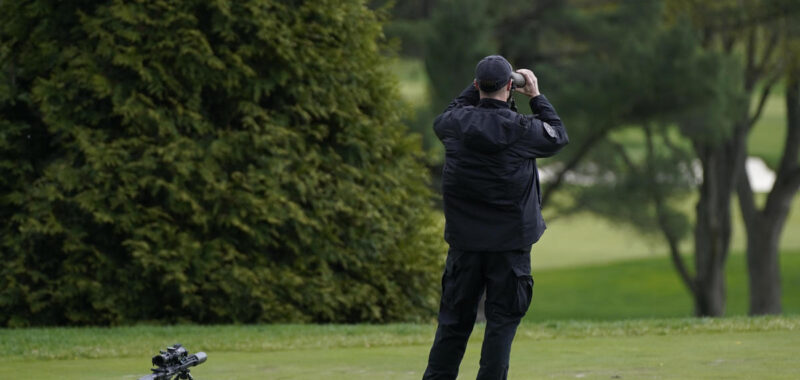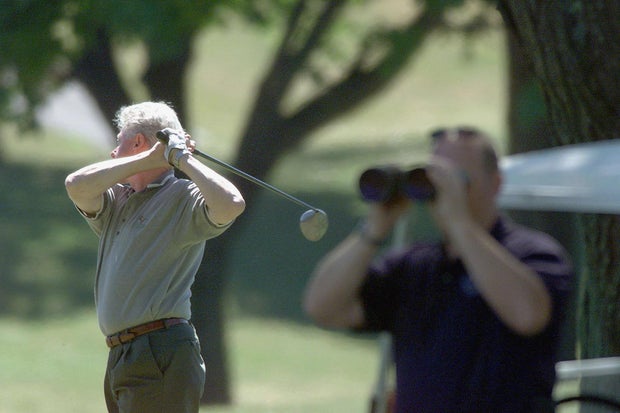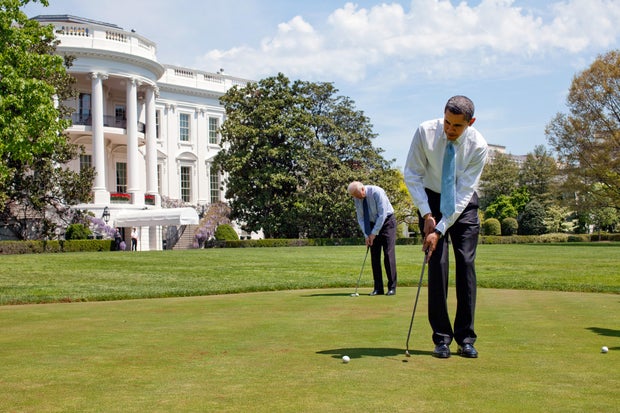Before President William Howard Taft ever stepped on a golf course as commander-in-chief, he was cautioned by his predecessor to avoid the sport altogether.
“I have received hundreds of letters protesting it,” then-President Theodore Roosevelt wrote to Taft, who was his secretary of war. Roosevelt warned that photo-ops of political leaders’ leisure-time activities could damage their public image. “Photographs of me on horseback, yes. Tennis, no,” he wrote. “And golf is fatal.”
Roosevelt was speaking figuratively, but the U.S. Secret Service views presidential golfing as a literal physical threat. While former President Donald Trump was on the fairway of the fifth hole at Trump International Golf Club last Sunday in West Palm Beach last Sunday, an advance agent spotted the barrel of a rifle jutting through barbed wire fencing along the tree line bordering the sixth-hole putting green. The gunman was apprehended, and the FBI is still investigating the apparent attempt on Trump’s life — the second in about two months.
JIM WATSON/AFP via Getty Images
Secret Service agents were given little time to survey the course for threats to Trump’s safety. According to two people familiar with the events, Trump’s protective detail was given roughly a 30-minute heads-up that he would play a round at his course Sunday, sending them scrambling to accommodate the unplanned outing.
“The president wasn’t even really supposed to go there,” Acting U.S. Secret Service Director Ronald Rowe told reporters this week. “It was not on his official schedule. And so we put together a security plan, and that security plan worked.”
“Off-the-record movements”
Trump’s round of golf is what the Secret Service calls an “off the record” or unplanned movement, an outing excluded from any public schedule. It’s the kind of excursion that usually offers far less time to prepare for agents tasked with shielding a president or former president from threats. Current and former agents likened it to President Biden’s last-minute pit stops for ice cream or President Barack Obama’s unannounced visits to nearby restaurants.
TIM SLOAN/AFP via Getty Images
“But if somebody’s going to lay down a bet in Vegas on a Sunday afternoon, they may just wager that the president’s going to play golf,” offered former Secret Service Deputy Director A.T. Smith, noting that while serving as an agent on then President Bill Clinton’s detail, he used to carry around three outfits in anticipation of his weekend ritual.
“We’d pack one outfit to go running, one to go to church, and a third to play golf,” Smith recounted.
Presidential respite turns into crisis
Golf outings offer the commander-in chief a rare respite from the churning demands of the Oval Office, but for the Secret Service agents who must scan fairways and putting greens, the assignment is a nightmare.
“In a perfect world, the Secret Service would rather the protectee never leave the house,” he added. “And that includes the White House.”
That nightmare first became a reality in October of 1983, when an armed man wielding a .38 caliber pistol pummeled his truck through an unmanned security gate and rumbled into the clubhouse, holding five hostages — including two Reagan aides — while demanding to speak with the president. The Secret Service reportedly whisked Reagan off the 16th hole and into a bulletproof limousine, but not before the president phoned the clubhouse to try and negotiate with his assailant. Charles Harris served five years in jail, but no one was injured.
A presidential putting green and namesake course
Since Taft first pierced the “green curtain” more than a century ago, sixteen presidents have stepped onto a golf course while in office, with President Dwight D. Eisenhower carding more than 800 rounds, according to the USGA. The avid golfer installed a putting green on the White House grounds in 1954.
Clinton — notorious for his “mulligans” — later moved it south of the Rose Garden, a short jaunt from the Oval Office, but nixed the sand bunker at the request of the U.S. Secret Service, who feared the president might knock a wedge shot through a West Wing window, according to Golf.com.
Hum Images/Universal Images Group via Getty Images
While in office, Trump preferred his namesake golf courses. According to a count by former CBS News White House correspondent Mark Knoller, Trump played golf at his heavily trafficked club in West Palm Beach 89 times during his presidency, with frequent outings to his other courses in Sterling, Virginia, and Bedminster, New Jersey, too. The latter suffered tens of thousands of dollars in damages back in 2017, after Clifford Tillotson allegedly used chemicals to etch anti-Trump messages in the greens, first reported by Bloomberg, at the time.
The day after Sunday’s incident at his Florida course, Rowe advised Trump during a closed-door meeting that it is unsafe for the former president to keep golfing without additional security measures, a senior official with the Trump campaign confirmed to CBS News.
The protective bubble
“The Secret Service isn’t authorized to protect the former president’s golf courses 24 hours a day,” said Paul Eckloff, a former Secret Service agent and assistant detail leader for Trump, who has protected him at golf courses “dozens of times,” including at the club in West Palm Beach.
Trump’s 27-hole course, an 8-minute drive from his residence at Mar-a-Lago, features wide open spaces interspersed with rows of swaying coconut palms and a 58-foot waterfall. Those terrain features offer cover to the former president when he plays, but they also conceal potential threats, current and former agents tell CBS News.
“On a golf course, the detail needs to stay a terrain feature ahead and a terrain feature behind to create that perimeter of protection for the former president or whoever it is that we’re protecting,” said Mike Matranga, a former U.S. Secret Service agent assigned to Obama’s detail.
But while Matranga considers Sunday’s response “a win” for the agency, he added, “The Secret Service should have had a counter surveillance or additional tactical element in that wood line with a K-9 sweeping the area,” a reference to where Ryan Routh lingered in the brush for nearly 12 hours, according to evidence retrieved by the FBI from the suspect’s cell phone. Routh currently faces two firearms charges over the incident.
During his U.S. Secret Service training, Matranga ran drills simulating an attack on a protectee at the links on Andrews Air Force Base, the same golf course where he routinely accompanied Obama for weekend rounds.
After retiring from the agency, the 12-year-veteran of the U.S. Secret Service admitted he sold his clubs. “I never wanted to step foot on a golf course again.”
contributed to this report.




